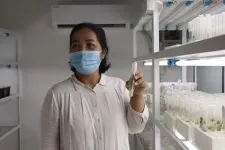(Press-News.org) Researchers at Columbia University Mailman School of Public Health and the New York City Department of Health and Mental Hygiene conducted the first representative survey of energy insecurity and health of New York City residents.
The study’s findings – including that energy insecurity is experienced by approximately 30 percent of New York City (NYC) residents – are published online and in print, in the February issue of the journal Health Affairs. The study and its results help officials understand challenges faced by residents and develop possible interventions and efforts in response.
Results show that the population of New York City was impacted by three or more indicators of energy insecurity defined as the inability to meet household energy needs. These residents had higher odds of respiratory, mental health, and cardiovascular conditions and electric medical device dependence than residents with no indicators.
Black non-Latino/a and Latino/a residents compared with White non-Latino/a residents, experienced significantly higher levels of energy insecurity as did renters compared with owners, recent immigrants compared with those living in the U.S. for longer, and those in households with children compared with those with no children.
“The issue of energy insecurity and how it affects population health is critical to understand,” said Diana Hernández, PhD, associate professor of sociomedical sciences at Columbia Mailman School of Public Health and co-Director of the Energy Opportunity Lab at the Center on Global Energy Policy, and senior author of the study. “Our findings confirm there is a need for more large-scale, comprehensive and collaborative studies of this type.”
In this study, as in previous research by Hernández and colleagues, a consistent pattern of unequal sociodemographic distribution of energy insecurity indicators emerges, with low-income, Black and Latino residents disproportionately affected. “The implications of these disparities are relevant from a health equity perspective, given that the burden of disease inequitably falls on many of the same populations,” said first author Eva Laura Siegel, a postdoctoral researcher at the Mailman School of Public Health.
Furthermore, observes Siegel, energy insecurity and its linked health risks are known to be exacerbated by poor-quality housing. “Unfortunately, higher risks of energy insecurity observed in these communities was not unexpected.”
A key contribution of this work is the presentation of a wider breath of indicators to characterize energy insecurity. Building on a narrower set of four indicators used in prior clinical and community-based studies, as well as the nationally representative Residential Energy Consumption Survey and an original survey designed by Hernández, the researchers developed a ten-indicator instrument to examine sociodemographic and health associations of energy insecurity in a representative sample of 1,950 New York City residents.
The researchers compared respondents who experienced three or more energy insecurity indicators with those who experienced two, one, or no indicators. Thirty-one percent of New York City residents experienced none of the ten energy insecurity indicators, 22 percent experienced one indicator, 18 percent experienced two indicators, and 28 percent experienced three or more indicators. The prevalence of three or more indicators was significantly higher among Black non-Latino and Latino residents (40 percent and 33 percent, respectively) compared with White non-Latino residents (18 percent).
More than one in four New York City residents experienced thermal discomfort at indoor temperatures
that were too cold (30 percent) or too hot (28 percent). Twenty-one percent had difficulty paying utility bills. Of those, a majority were in debt for energy costs. Receipt of a service disconnection notice
for electricity or gas because of debt or nonpayment and any service shutoffs for heat, electricity,
and gas were experienced by 8 percent and 3 percent of residents, respectively.
“This first citywide survey to characterize energy insecurity and its correlates with health and social vulnerability in New York City lays the groundwork for new avenues of exploration connecting energy insecurity and health,” said Kathryn Lane of the NYC Health Department. “Our study demonstrates that broadening the understanding of energy insecurity with context-specific metrics can help guide interventions and policies that address health inequities and improve health related outcomes,” said study co-author Ariel Yuan of the NYC Health Department.
Energy insecurity in New York City is distinctive, according to Hernández, as it’s a complex and dynamic phenomenon. “Our aim was to demonstrate the use of a broader set of energy insecurity indicators that reflects both qualitative and quantitative emerging evidence and deep ties to the local context.”
This line of inquiry and collaborative model is applicable beyond NYC. “Our joint endeavor demonstrates the role of health departments in measuring energy insecurity and related health impacts and the value of academic-government partnerships in expanding climate health research to inform policy development,” said Carolyn Olson of NYC DOHMH.
“The main takeaway,” said Olson, “is that access to affordable energy is a key to achieving health equity in climate change adaptation.”
Other co-authors are Lauren A. Smalls-Mantey, NYC Health Department; and Jennifer Laird, Lehman College, CUNY.
The study was supported by multiple grants from the Centers for Disease Control and Prevention, and the Alfred P. Sloan Foundation; the JPB Foundation; the Robert Wood Johnson Foundation; and the National Institute of Environmental Health Sciences, National Institutes of Health, (5P30ES009089-18).
Columbia University Mailman School of Public Health
Founded in 1922, the Columbia University Mailman School of Public Health pursues an agenda of research, education, and service to address the critical and complex public health issues affecting New Yorkers, the nation and the world. The Columbia Mailman School is the fourth largest recipient of NIH grants among schools of public health. Its nearly 300 multi-disciplinary faculty members work in more than 100 countries around the world, addressing such issues as preventing infectious and chronic diseases, environmental health, maternal and child health, health policy, climate change and health, and public health preparedness. It is a leader in public health education with more than 1,300 graduate students from 55 nations pursuing a variety of master’s and doctoral degree programs. The Columbia Mailman School is also home to numerous world-renowned research centers, including ICAP and the Center for Infection and Immunity. For more information, please visit www.publichealth.columbia.edu
END
First representative survey of energy insecurity in New York City
2024-02-05
ELSE PRESS RELEASES FROM THIS DATE:
Primary care housing intervention linked to improved patient health outcomes
2024-02-05
Brigham researchers found that participation in a housing program was associated with fewer outpatient visits, improved physical and mental health, and stronger connections to their primary care clinics and care team.
Lack of safe and affordable housing is a critical issue in the United States and creates immense challenges for patients’ health, well-being, and ability to access care. Investigators from Brigham and Women’s Hospital, a founding member of the Mass General Brigham healthcare system, evaluated data from a social ...
MSU researchers find early, promising glioblastoma treatment
2024-02-05
MSU has a satellite uplink/LTN TV studio and Comrex line for radio interviews upon request.
EAST LANSING, Mich. – A team of Michigan State University scientists has unveiled a potential game-changer in the fight against glioblastoma, the most common and currently incurable form of brain cancer.
A team of Michigan State University scientists has unveiled a potential game-changer in the fight against glioblastoma, the most common and currently incurable form of brain cancer.
Their weapon of choice? ...
Are body temperature and depression linked? Science says, yes
2024-02-05
People with depression have higher body temperatures, suggesting there could be a mental health benefit to lowering the temperatures of those with the disorder, a new UC San Francisco-led study found.
The study, publishing today in Scientific Reports, doesn’t indicate whether depression raises body temperature or a higher temperature causes depression. It’s also unknown whether the higher body temperature observed in people with depression reflects decreased ability to self-cool, increased generation of heat from metabolic processes or a combination of both.
Researchers analyzed data from more than 20,000 international ...
Persons diagnosed with PCOS face 8-fold increase in suicide risk
2024-02-05
Embargoed for release until 5:00 p.m. ET on Monday 5 February 2024
Annals of Internal Medicine Tip Sheet
@Annalsofim
Below please find summaries of new articles that will be published in the next issue of Annals of Internal Medicine. The summaries are not intended to substitute for the full articles as a source of information. This information is under strict embargo and by taking it into possession, media representatives are committing to the terms of the embargo not only on their own behalf, but also ...
Mental health care during the COVID-19 era remains inaccessible to many distressed US adults
2024-02-05
U.S. adults experienced considerable psychological distress and adverse mental health effects as a result of the COVID-19 pandemic according to a study at Columbia University Mailman School of Public Health and Columbia University Irving Medical Center. Based on insurance claims, mental health care provider surveys, and electronic health records the research further revealed a decline in in-person outpatient mental health visits during the acute phase of the pandemic. Findings are reported ...
Magnesium protects tantalum, a promising material for making qubits
2024-02-05
UPTON, NY—Scientists at the U.S. Department of Energy’s (DOE) Brookhaven National Laboratory have discovered that adding a layer of magnesium improves the properties of tantalum, a superconducting material that shows great promise for building qubits, the basis of quantum computers. As described in a paper just published in the journal Advanced Materials, a thin layer of magnesium keeps tantalum from oxidizing, improves its purity, and raises the temperature at which it operates as a superconductor. All three may increase tantalum’s ability ...
From Colombia to Laos: protecting crops through nanotechnology
2024-02-05
In a recent breakthrough, DNA sequencing technology has uncovered the culprit behind cassava witches’ broom disease: the fungus genus Ceratobasidium.
The cutting-edge nanopore technology used for this discovery was first developed to track the COVID-19 virus in Colombia, but is equally suited to identifying and reducing the spread of plant viruses. The findings, published in Scientific Reports, will help plant pathologists in Laos, Cambodia, Vietnam and Thailand protect farmers’ valued cassava harvest.
“In Southeast ...
New guideline details acute pain management strategies for adolescent, adult dental patients
2024-02-05
CHICAGO, Feb. 5, 2024 – Nonsteroidal anti-inflammatory drugs (NSAIDs) taken alone or along with acetaminophen are recommended as first-line treatments for managing short-term dental pain in adults and adolescents aged 12 or older, according to a new clinical practice guideline developed by the American Dental Association (ADA), the University of Pittsburgh School of Dental Medicine and the Center for Integrative Global Oral Health at the University of Pennsylvania School of Dental Medicine. The guideline has been endorsed by the ADA and is now available in the February issue of The Journal ...
How ‘deaths of despair’ differ by race and ethnicity
2024-02-05
COLUMBUS, Ohio – White Americans are more likely than Black and Hispanic people in the United States to experience “deaths of despair” even though they are less likely to suffer from severe psychological distress, a new study finds.
The results suggest that, for some reason, whites are more vulnerable to the damaging effects of psychological distress than Blacks or Hispanics, said Hui Zheng, lead author of the study and professor of sociology at The Ohio State University. Zheng is currently on leave at the University of Hong Kong.
“The white population has an increasing trend of despair-related mortality after 2000,” Zheng said. ...
Understanding how soil traps carbon
2024-02-05
EVANSTON, Ill. — When carbon molecules from plants enter the soil, they hit a definitive fork in the road.
Either the carbon gets trapped in the soil for days or even years, where it is effectively sequestered from immediately entering the atmosphere. Or it feeds microbes, which then respire carbon dioxide (CO2) into the ever-warming environment.
In a new study, Northwestern University researchers determined the factors that could tip plant-based organic matter in one direction or the other.
By combining laboratory experiments and molecular modeling, researchers ...


